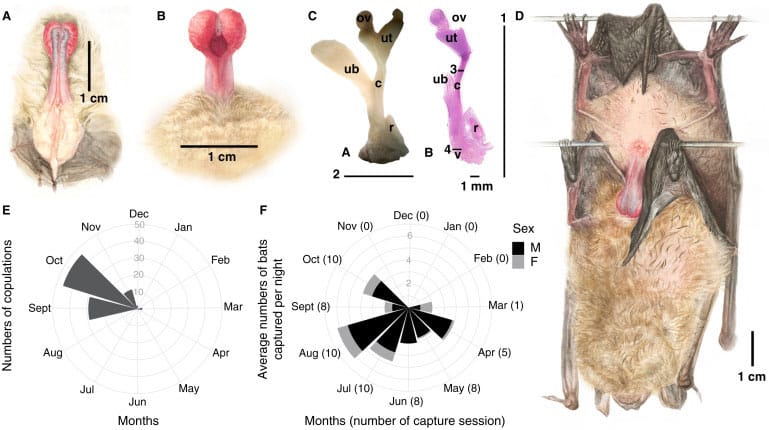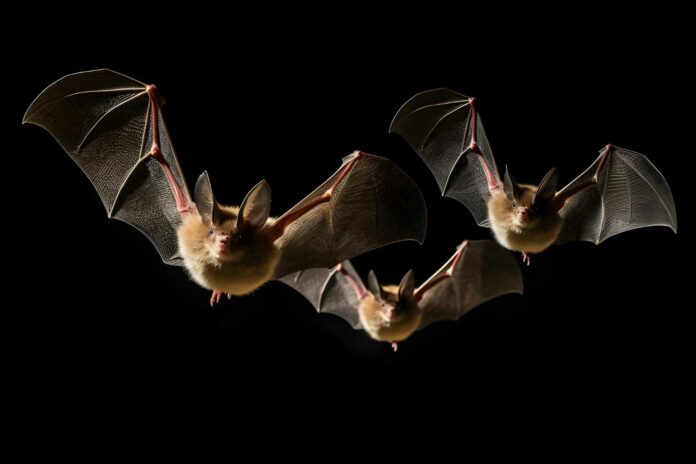In a new study, scientists unraveled how male serotine bats have sex. These bats have rewritten the rules of mammalian mating, opting for a style more reminiscent of birds than their furry counterparts.
Background:
All mammals mate by penetration. Several aspects of bat reproduction differ from other mammals. The unusual genitals of male serotine bats have thrown this into doubt.
Male serotine bats have a penis that is as much as seven times wider and longer than the female’s vagina. A heart-shaped terminal swelling characterizes its disproportionately large penis. Because of the organ’s unusual structure, its possible function becomes a perplexing question. Indeed, intromission might not be feasible.
Study:
Scientists found that in serotine bats (Eptesicus serotinus), the penis is used as a ‘copulatory arm’ rather than an intromittent organ. It means the animals touch their genitals together to mate. This sex style is more similar to birds than any known mammal, which typically combines multi-purpose organs called cloacas to reproduce.
Dr Nicolas Fasel, the lead author of a new paper on the issue, says, “We were quite surprised to see this, as mammals have only ever been observed copulating by intromission before.”
“It’s possible that it’s not just limited to serotine bats, as I’ve observed similarly strange genitals in other bats. We now aim to get some funding to describe copulatory behaviors in other species and explore the more secretive aspects of bat reproduction.”

Reproduction in bats:
It was believed up until this time that mating involved one mammal penetrating the other with their penis, as was the case with all other mammals. However, scientists realized this might not be the case while examining serotine bats, widely distributed throughout most of Europe and Asia.
The team watched hours of video from a Dutch church that the bats were known to visit, and they also watched captive bats in a Ukrainian bat rehabilitation center, which allowed them to witness the mating process in the most personal detail.
They observed that male serotine bats had a hair-covered “heart-shaped” structure on the tip of their penis when they were fully erect. According to the team, this functions as a “copulatory arm,” repositioning the female’s tail membrane to allow males to feel their way to the ideal mating position.
To copulate, the male then touches their penis to the female’s vulva. On average, these mating sessions last 53 minutes but have occasionally lasted longer than half a day.
Sexual conflict:
Over time, males and females of the same species evolve in response to each other as they try to get the upper hand. This is sexual conflict. It can involve changes in body size, characteristics, and behavior.
The unusual reproduction of the serotine bats, like many insect-eating bats, is an example of this conflict.
However, serotine bat females have modified this structure to serve as a defense against rogue males by covering their lower bodies and shielding them from uninvited suitors.
Males appear to have adjusted their genitals in response, pushing the membrane aside to facilitate mating, which has led to the development of an enlarged penis.
Conclusion:
The discovery unveiled a remarkable chapter in the world of mammalian reproduction. As researchers continue exploring bat behaviors, this discovery challenges our understanding of mating norms and showcases the fascinating adaptations that can arise in the battle of the sexes.
Journal Reference:
- Nicolas Fasel, Jan Jeucken, Kseniia Kravchenko et al. Mating without intromission in a bat. Current Biology. DOI: 10.1016/j.cub.2023.09.054
